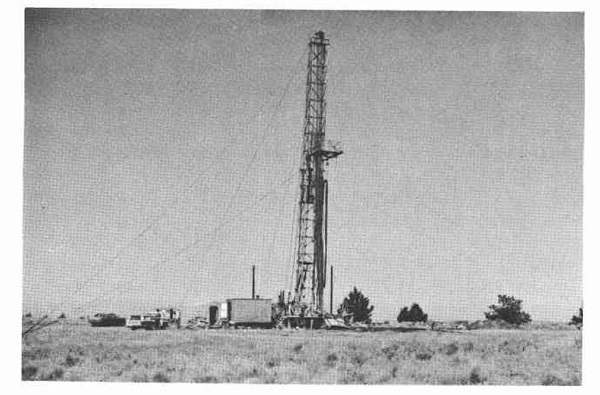Three petroleum exploration companies will risk everything on one well trying to become successful Oregon wildcatters.

The Morrow No. 1 well, an ill-fated wildcat well first drilled in 1952 in Jefferson County, Oregon. Photo courtesy Oregon Department of Geology and Mineral Industries, “The Ore Bin,” Vol. 32, No.1, January 1970.
Searching for oil has always been an expensive and risky investment, but the lure of black gold has invited speculators since the First American Oil Well.
Under-capitalized operations are often funded with public sales of stock to enable continued drilling. It’s a high-risk investment. About nine out of ten wildcat wells have failed to find commercial amounts of oil since 1859.
Many small ventures must bet everything on drilling a first successful well to have a chance at a second. A gusher means wealth; a dry hole means bankruptcy. And so it was on a remote hillside in Jefferson County, Oregon.
Three companies searched for riches from the same well.
Northwestern Oils Inc.
The first of these three Oregon wildcatters, Northwestern Oils, incorporated in 1951 with $1 million capitalization in order to “carry on business of mining and drilling for oil.”
With offices in Reno, Nevada, in early 1952 Northwestern Oils began drilling a test well about eight miles southeast of Madras, Oregon. Using a cable-tool drilling rig (see Making Hole – Drilling Technology), drillers reached a depth of 3,300 feet on the Baycreek anticline before work was suspended because of “lost circulation troubles.”
Circulation troubles continued with the Morrow No. 1 well – also known as the Morrow Ranch well – in Jefferson County (Section 18, Township 12 South, range 15 East). By March 1956, with no money and no additional drilling possible, Northwestern Oils’ assets were “seized for non-payment of delinquent internal revenue taxes due from the corporation” and auctioned off at the Jefferson County courthouse.
Central Oils Inc.
Central Oils (Seattle) also was formed in 1956. With plans to join the other rare Oregon wildcatters, the Central Oils registered with the Security and Exchange Commission on July 30, 1958. It sought to sell one million shares of stock to the public at 10 cents a share. Proceeds would finance leasing and drilling, just like Northwestern Oils.
The company received a permit to deepen Northwestern Oils’ old Morrow Ranch well in 1966 and planned to continue drilling with a cable-tool rig. Nothing happened.
“Commencement of this venture has been delayed until the spring of 1967,” one newspaper reported. But Central Oils had run afoul of the SEC. Oregon regulators recorded the well abandoned as of September 12, 1967, and Central Oils “out of business; no assets.”
Robert F. Harrison
In May 1968, Robert F. Harrison and his associates took over the same well – this time with plans to deepen it to more than 5,000 feet. But two years later the drilling effort was still stuck at 3,300 feet. Desperate, Harrison tried to clear the borehole by applying technologies for Fishing in Petroleum Wells.
On February 2, 1971, an intra-office report noted that R.F. Harrison “will abandon as soon as weather permits,” never having exceeded the original Northwestern Oils total depth of 3,300 feet. It would be a dry hole.
Harrison finally plugged and abandoned the Morrow No. 1 well as of October 12, 1971. Today, Oregon’s Department of Geology and Mineral Industries identifies this stubborn dry hole as well number 36-031-00003. There has never been a successful oil well drilled in Oregon.
America’s First Dry Hole was drilled in 1859 by John Grandin of Pennsylvania – near and just a few days after the first commercial discovery. In 2014, U.S. oil wells produced more than 8.7 million barrels of oil every day, according to the Energy Information Administration.
___________________________________________________________________________________
The stories of many exploration companies trying to join petroleum booms (and avoid busts) can be found in an updated series of research in Is my Old Oil Stock worth Anything?
AOGHS.org welcomes sponsors to help us preserve petroleum history. Please support this energy education website with a donation today. Contact bawells@aoghs.org for information on levels and types of available sponsorships. © 2018 AOGHS.

